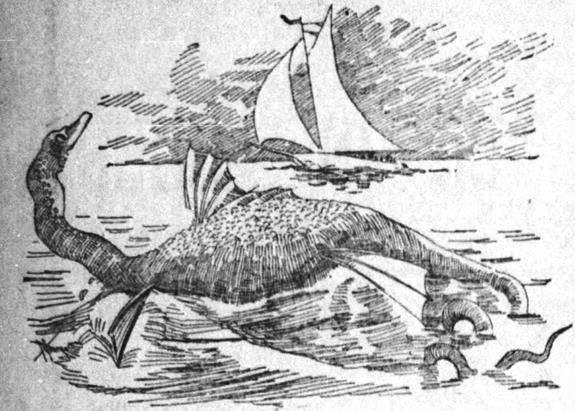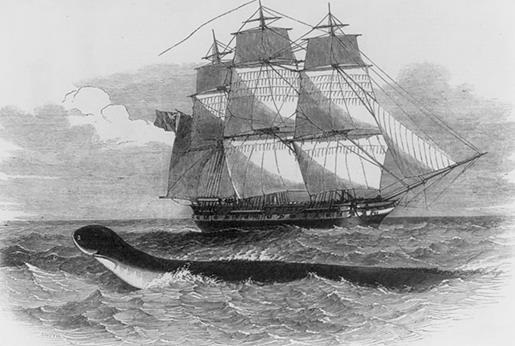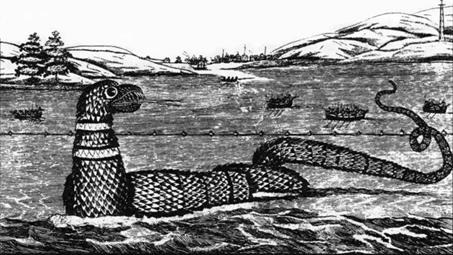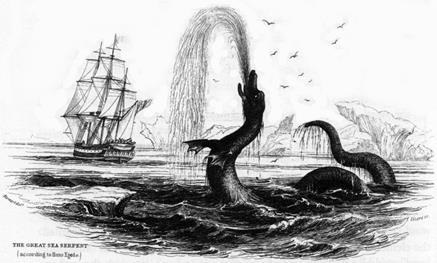
By BOB THIBAULT
On an otherwise normal Thursday in May 1886, a remarkable event occurred in Sea Isle City. The borough was visited by a massive SEA SERPENT – right there on the beach at Townsends Inlet.
There are no photos or contemporary sketches of the creature, but a frighteningly detailed description appeared in the Philadelphia News a week later.
The scene was described by two independent sets of observers at different times of day, observers who weren’t aware of the existence of one another. That seems to give the story at least a modicum of validity. Something happened.
Some Serpent Lore
Do sea serpents really exist? As far back as 2,000 years ago, Virgil spoke of seeing a matched pair of serpents with fiery eyes and hissing tongues. And the number of sightings grew through the years.
But it wasn’t until the 18th and 19th centuries when sailors, possibly encouraged by a little grog, began to spot them all over the place.
The first memorable event on the eastern seaboard of the U.S. occurred in 1817 when the “Gloucester Serpent” was observed frolicking offshore in the Gulf of Maine. It appeared intermittently for three years in a row, including forays up and down the Atlantic Coast.
This guy – they were all called “guys” in those days – was described as 60 to 80 feet long with a head like a horse, and looked pretty much like an overgrown snake. He was observed by hundreds of people, including the renowned Daniel Webster, all of whom swore that the creature was authentic. Scientists even gave him a name (“Scoliophis Atlanticus”) and declared him to be a whole new species.
And so it went. The number of serpents sighted in the 19th century probably counted into the hundreds and reached a peak in the 1880s and 1890s. P.T. Barnum once offered $20,000 to anyone who could provide him with the genuine article, but it appears he never had to lay out the cash.
New Jersey Had Its Share
When a sea serpent popped up in Sea Isle City in 1886, it was not a unique occurrence for the Garden State. Some examples of contemporary Jersey sightings:
- Five members of the Long Branch life-saving crew spotted a black, 100-foot-long serpent with stubby horns and two blow holes. (1)
- A visitor to Ocean Beach came upon a dark brown, 100-foot reptile with a head like a lizard’s and with bulging eyes the size of saucers. (2)
- A Long Branch fisherman discovered a 25-foot pink specimen with “great excrescences upon his head” disporting in the surf. (3)
- H.W. Hand, Jr. and Harry Ludlam found an 11½-foot specimen at Sewell’s Point. Its body was two feet thick and covered with coarse hair. The mouth was reported to be large enough to engulf Harry. (4)
- In 1888, the famous Daedalus Serpent purportedly made an appearance in New Jersey, sunning itself in the river near Oceanic. (5)
(Back on August 7, 1848, a major sighting had occurred when a 65-foot serpent was discovered by the crew of the HMS Daedalus off the Cape of Good Hope. Many followers of serpent lore contend that this creature traveled the world and endured for at least a half-century. August 7 is still quietly celebrated as “National Sea Serpent Day” in honor of the Daedalus event.)

Closer to Home
- A cat-rigged yacht with Joe Ludlam at the helm, carrying a contingent of hotel-keepers, was sailing in the vicinity of Anglesea Beach when J.J. Sturmer of the Rosemont Cottage saw a great commotion in the water. Captain Joe declared it was a veritable sea serpent – 100 feet long with a head as big as a bell buoy, with two projecting horns sticking straight out of the water. Formal affidavits were sworn as to the veracity of the sighting. (6)
- Two months later, even closer to home, two yachts had engaged in a race from Sea Isle to Hereford Inlet. On the return trip, one of the competitors remarked, “I think I see the sea serpent.” As the yacht, the William Boothby, drew closer, the creature was seen to be about 60 feet in length with a “horrid-looking” head, protruding eyes, a mouth that would fit a beer keg, and bright scales as big as silver dollars.
The serpent apparently didn’t like the looks of the Boothby, either. It made for the Avalon drawbridge, “running like the devil” until the crew managed to harpoon it in the neck. Then somehow the serpent towed the yacht back toward Hereford Inlet and was eventually cut loose. Last seen, the wounded creature was headed toward the Cape May Lighthouse. (7)
Sea Isle Gets Its Own Serpent
This (almost) unbelievable report appeared in the Philadelphia News on June 5, 1886, and was picked up by newspapers around the country:
First Sighting:
On Thursday, May 27, Eddie Allen, a 10-year-old boy from Philadelphia, was spending the day at Sea Isle City with his father and his sister.
Mr. Allen sat on the porch of the Sea View House smoking a cigar while the boy gathered shells on the beach. At about 4 p.m., Eddie ran back to the hotel “with eyes as big as saucers” and told his father that he’d seen a funny little fish on the sand with legs and wings. He pointed toward Townsends Inlet.
His sister, who was about twice Eddie’s age, was sent to investigate. Her story was even more remarkable. Miss Allen declared that not only was there such a creature, but that in addition to four or five legs and a pair of wings, it had only one eye. And it had “a tail that wriggled and twisted like that of a snake.” The adults all laughed.
That same day, the Allen family took the train back to Philadelphia. And that would have been the end of that, were it not for the curious events which followed.
Second Sighting and the Chase:
On the next morning, Jerry Delaney, a Sea Isle City Councilman who kept a sporting resort on the island, sent Tom Brophy to the inlet to get a bushel of oysters. When Tom returned he was all out of breath. “Bless my bloomin’ ‘art,” he sputtered, “if I haven’t seen the devil a slashin’ of his tail up there by the inlet … ’Ees there as big as life.”
It so happened that there were some early birds in Delaney’s bar at the time sipping their morning orange juice. When they heard Tom’s story, a man named Andrew Ellis proposed an investigation into the unlikely affair. His proposal was seconded, and five would-be adventurers decided to put aside their daily duties and join a horse-and-buggy safari to the inlet to see what was going on. (For the record, these men were Ellis, Greenfield, Smith, Gaines and Horfield).
When they drew within a quarter-mile of the spot Brophy had claimed to have made his discovery, they spotted a “big moving mass” in the distance, which turned out to be at least 150 feet long, according to Mr. Ellis, who professed to “have a good eye for measurements.”

The entire troupe jumped out of the wagon to have a better look. In Ellis’s own words: “It had a head something like that of a catfish in shape, only the mouth was V-shaped in the middle and underneath was a long reddish beard. The color of the head was a sort of fawn and right in the middle of the forehead there was a circular patch of transparent skin, which at first looked like a gigantic eye.”
But when Ellis produced a pair of opera glasses, he had a better look at that transparent patch which sat about 12 inches above the mouth. Again, in his own words:
“I could distinctly see … the pulsating of the creature’s brain through that window of clear skin,” an interpretation verified by Mr. Gaines and Mr. Smith. Ellis went on to say that the monster sported a pair of wings or fins which, when extended, “stood out like the sails of a small yacht.”
Now the adventurers wanted an even closer view, so they started to advance “at a brisk pace.” This apparently unnerved the beast and it turned broadside to expose three webbed feet, each about three feet in diameter. The body appeared to be about “a hogshead” across at the middle section with red splotches all over it. And with this different view of the head, they assessed it to be a full seven feet across with two very small eyes about four inches above the mouth.
Then Mr. Gaines Shot It In The Head (The part about the ax comes later)
Although the gratuitous shot was fired point blank, it seemed to have had no physical effect on the creature; it simply flapped its “wings” and backed into the sea about 200 yards from shore. The explorers followed as far as they could. Then came the most astounding part, if that’s possible.
(Remember that when 10-year-old Eddie Allen had described his discovery on the previous day, he called it a “funny little fish.” This was certainly not the 150-foot monster encountered by the contingent from Delaney’s bar. But that can be explained by what followed.)
As the five men approached the surf, they spotted two “diminutive monsters which were exact counterparts of the big one.” This must have been what Eddie saw – possibly the first baby sea serpents on record, anywhere. And the big “guy” was their mother.
Brophy and Ellis managed to snare one of the smaller creatures which gave out a squeak. It was answered by the mother with something that sounded like the howl of a tiger. She lifted herself out of the water and began pulling at her beard with one of her webbed feet. That must have been quite a sight. Then things got worse.
The little one (about three feet long) finally got away. But Brophy ran back to the wagon, grabbed an ax, chased after the escapee, grabbed hold, and proceeded to hack it in half. He secured the front part, which he later sold for a dollar. The other young one swam out to its mother, climbed up on her back – and they were outta’ there.
When the adventurers returned to Delaney’s, they were, of course, laughed at. But they knew differently. Andrew Ellis even swore an affidavit asserting the truth of the matter before a Justice of the Peace. Believe it or not.
Most sea serpents have been debunked by “scientists” who profess to know better than the multitude of in-the-flesh eyewitnesses who swear by them. Skeptics have identified various serpents as a strung-out pod of narwals, a humpback whale trailing debris, a congregation of plovers, a basking shark, a giant oarfish. Or even a surviving prehistoric monster. How about simply an overgrown mutant sea snake? It’s fun to think about – from a distance.
Nessie, the Loch Ness Monster, may be a case in point. She became famous in the 1930s – and still is. The 1934 image (of the creature) is a proven fake, but people still believe. It’s estimated that the search for Nessie adds $54 million to the Scottish economy each year.
Newspaper References:
- York, Pa. Gazette – December 11, 1883
- Camden Morning Post – July 15, 1885
- Passaic Daily News – June 18, 1886
- Camden Daily Telegram – November 4, 1887
- Bridgewater Courier-News – August 17, 1888
- Philadelphia Times – April 28, 1890
- Philadelphia Times – June 22, 1890
- The Hartford Courant – August 10, 1897
To enjoy the collection of photos, literature, and artifacts, plan to visit the Sea Isle City Historical Museum at 48th Street and Central Avenue in the future (the museum is temporarily closed due to COVID-19). Access the website at www.seaislemuseum.com or call 215-595-4601 for more information.
Bob Thibault is a volunteer at the Sea Isle City Historical Society.








